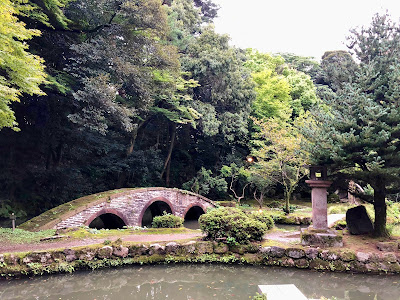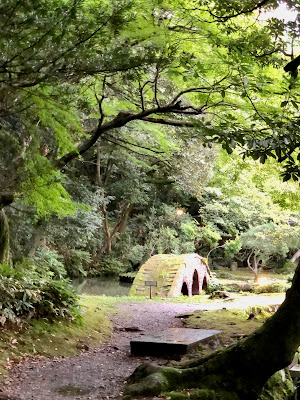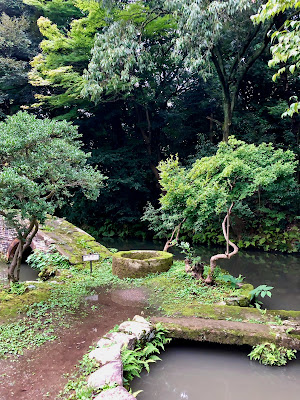目次 / Contents
1) 庭の位置 / Garden Position
A. 金沢城の一部 / A Part of Kanazawa Castle
B. 金谷御殿 / Kanaya Goten
C. 水 / Water
2) 菊桜 / Kiku-zakura
3) 夏の夕刻 / Summer Evening Twilight
4) 楽器の庭 / Garden of Musical Instruments
A. 雅楽 / Gagaku
B. 図月橋 / Togetsu-bashi Bridge
C. 琴橋 / Koto-hashi Bridge
D. 仄暗い / Gloomy
5) "母子順風の像" / "Statue of Mother and Child in Fair Wind"
6) さし石 / Strength Stones
1) 庭の位置 / Garden Position
A. 金沢城の一部 / A Part of Kanazawa Castle
金沢在住の友人、Sちゃんと、私は尾山神社へ行きました。
尾山神社については前のセクションです(下記)。
 |
| ⭕️ : 尾山神社 / Oyama Shrine Map of Kanazawa Castle Town in Kaga Province, 1668 |
A Part of Kanazawa Castle
S Chan, one of my friends who lives in Kanazawa, and I visited
This section is about Oyama Shrine Garden: ★.
About Oyama Shrine is the previous section, below.
Oyama Shrine is a place where was a part of Kanazawa Castle, was called 'Kanaya-demaru'.
In front of Oyama Shrine, there was a defensive line called 'Sougamae; : Enclosed Moats'' consisting of earthworks and moats.
I think that it is a delicate position of the boundary between the inner hull and outer hull.
B. 金谷御殿 / Kanaya Goten
隠居した藩主の居住地となりました。
ちなみに、吉徳といえば、加賀騒動 (1748) のきっかけを作った人物として後世に知られています。
吉徳は、悪いことはしていず、藩に尽くし、藩を救った人物と私は
理解しています。
話を庭に戻します。
当初の庭は、4代加賀藩主、5代加賀前田家当主、
江戸期に前田家が築いた最後の庭園です。
地泉廻遊式 (チセンカイユウシキ)で、石川県指定名勝になっています。
廃藩置県 (ハイハンチケン/ 1871) が実施され、金谷御殿の最後の
主人は、12代加賀藩主、13代加賀前田家当主、
 |
| 境内の地図 / Map of Precincts: ★ 尾山神社の歴史と由来はここで→★ ❶ 本殿 / Main Hall ❷ 拝殿 / Worship Hall ❸ 神門 / Main Gate ❹ 利家公像 / Toshiie Statue ❺ お松の方像 / O-Matu-no-Kata Memorial Stone ❻ 授与所 / Conferment Place ❼ 金谷神社 / Kanaya Shrine ❽ 東神門 / East Gate ❾ 神苑 / Garden : Shin-en 画像は下記より / This from below★ |
Kanaya Goten
After the era of Maeda Yoshinori (1690 - 1745), the 5th lord of Kaga Domain as well as the 6th hereditary chieftain of the Kanazawa
Maeda Clan, the building became the residence of the retired domain lord called Kanaya Goten : Kanaya Stately Mansion.
By the way, speaking of Yoshinori, he is known to later generations as the person who triggered the Kaga Sōdō / Kaga Feud : one of
I understand that Yoshitoku did nothing wrong, served the domain, and saved the domain.
Back to the garden.
The original garden was maintained by Tsunanori Maeda (1643 - 1724), the 4th lord of the Kaga domain and the 5th hereditary chieftain of the Kanazawa Maeda Clan.
The current garden : Shin-en : ❾ is said to have been created between the end of the Edo period and the establishment of the shrine (1873).
The Shin-en was the last garden built by the Maeda family during the Edo period.
The garden : Shin-en is Chisen Kaiyu style garden (a style of Japanese garden with a path around a central pond) which is Ishikawa Prefecture Designated Scenic Beauty.
(1871) were implemented, and the last master of Kanaya Goten was the 12th lord of the Kaga Domain as well as the 13th head of the Kaga Maeda family, Maeda Nariyasu (1811 - 1884).
 |
| 金谷御殿と庭 (上部) Kanaya Goten and Garden (top) 画像は下記より / This from below ★ |
C. 水 / Water
 |
| 響音瀑 私が訪ねたときは、水が枯れ気味で、 音は響いていませんでした。 Kyō-on-baku Waterfall (echoing sound of waterfall) When I visited, no water flowed and there was no sound. |
Water
The main of the Chisen Kaiyu style garden is the pond.
The water of the Shinen Garden was drawn from the Tatsumi Canal yōsui, fed to the waterfall ; Kyō-on-baku Waterfall above then down into the pond.
The Canal was completed by order of Toshitsune Maeda (1594 - 1658), the second lord of the Kaga Domain and the third head of the Kaga Maeda family.
Currently, the waterway has been cut off, so they dug, made a well and groundwater is flowing into the pond.
Although the Tatsumi Canal yōsui is no longer used here, there are still several places in Kanazawa that still use the Tatsumi Canal yōsui, giving me a sense of both history and the present.
2) 菊桜 / Kiku-zakura
3) 夏の夕刻 / Summer Evening Twilight
人の背よりも高い、黒い金属製のハスと金色のカエルのオブジェが
ありました。
「何故ここに?何か、伝説でもあるのかしら?」
と思いつつ撮影しました。
のちにそれは、鍛鉄工芸家 (タンテツコウゲイカ) の
鍛鉄または錬鉄(レンテツ) : Wrought Ironは、炭素の含有量が少ない鉄です。
炭素が少ない鉄は強靭、耐腐食性があるそうです。
パリのエッフェル塔は、この素材の代表的な建築物です。
エッフェル塔からカエルくんたちに話を戻します。
ハスとカエルの作品には、"夏の夕刻"というロマンチックなタイトルがついています。
鍛鉄と枕木使用のベンチも作品で、"山笑う"という、豪快なタイトルがついています。
この作品を気に入った石川県内の会社社長が購入し、神社へ奉納したそうです。
蓮・大:直径約1.7m / 高さ2.4m
蓮・小:直径約1.4m / 高さ2.1m
ベンチの長さ:2.1m
Large Lotus: about 1.7m in diameter
2.4m in height
Small Lotus : about 1.4m in diameter
2.1m in height
Bench length: 2.1m
Summer Evening Twilight
There are black metal lotus and a golden frog objects that are taller than a person.
While I wondered,
"Why are you here? Is there some kind of legend?"
I photographed.
Later, I found that they were created by Mitsuo Nishida (1951~), a wrought iron craftsman, and the staff of Nishida's studio, "PAGE ONE" : ★.
[From Kanazawa Economic Newspaper : ★ only in Japanese]
Wrought iron is iron with a low carbon content.
Iron, which contains less carbon, is stronger and more resistant to corrosion.
The Eiffel Tower in Paris is a typical architectural example of this material.
Back from the Eiffel Tower to the frogs.
The lotus and frogs works have a romantic title, "Summer Evening Twilight".
A bench made of railroad ties and the iron is also a work, and has a daring title, "Mountain Laughs".
A president of a company in Ishikawa Prefecture liked these works, purchased them and dedicated to the shrine.
4) 楽器の庭 / Garden of Musical Instruments
A. 雅楽 / Gagaku
多くの日本庭園が自然の風景や禅の思想を'見立て'を通して取り入れています。
ですが、ここは、雅楽 (ガガク)に関連する'見立て'や名前が多く、
'楽器の庭'とよばれています。
神社で伝統的に演奏される音楽は、雅楽なので、このモチーフが選ばれたのでしょうか?
それとも金谷御殿の時代から、'楽器の庭' であったのでしょうか?
どちらにしても、現在は、雅楽というテーマは、ここにあっています。
島は、
鳳笙島 (ホウジョウジマ) または笙島 (ショウジマ)、
琵琶島 (ビワジマ)
鳥兜島 (トリカブトジマ)
の3つがあります。
橋は、島々を巡る形で、図月橋 (トゲツバシ)、琴橋 (コトハシ)、
八ツ橋 (ヤツハシ) などがあります。
'1) 3. 水' で、前述した響音瀑は、滝石組 (タキイワグミ)です。
私が撮影した際には、この庭の詳細は、何も知りませんでした。
次回またこの神社に訪れる機会に恵まれたら、これらのことを意識しながら見学したいと思います。
 |
| 尾山神社の庭 左の橋は図月橋です。 Garden of Oyama Shrine The bridge on the left is Togetsu-bashi Bridge. |
Gagaku
Many Japanese gardens incorporate natural landscapes and Zen ideas through 'Mitate' ; to be like.
However, there are many ''Mitate'' and names related to Gagaku here, so it is called 'Musical Instrument Garden'.
According to Wiki about Gagaku ,
"Gagaku is a type of Japanese classical music that was historically used for imperial court music and dances. "
The music traditionally performed at shrines is Gagaku, so was this motif chosen?
Or has it been the 'Musical Instrument Garden'' since the days of the Kanaya Goten?
In any case, the theme of Gagaku today now suits here.
There are three islands,
Hōshō -jima or Shō-jima Island,
Biwa-jima Island,
Torikabuto-jima Island.
There are bridges that link the islands, such as Togetsu-bashi Bridge, Koto-hashi Bridge, and Yatsu-hashi Bridge.
In '1) 3. Water', Kyō-on-baku Waterfall mentioned earlier, it is Takiiwagumi : waterfall made of stones.
I didn't know anything about this garden when I photographed.
If I have the opportunity to visit this shrine again next time, I would like to visit here while being aware of these things.
 |
| 鳳笙または笙 笙は、雅楽の管楽器の一つです。 Hōshō or Shō Hōshō or Shō is one of the free reed musical instruments of Gagaku. 画像は下記より / This from below ★ |
 |
| 月百姿・足柄山月 作:月岡 芳年 (ツキオカ ヨシトシ / 1839 - 1892) 笙を吹く源 義光 (ミナモトノヨシミツ/ 1045 - 1127) Mount Ashigara Moon By Tsukioka Yoshitoshi (1839 - 1892) Minamoto no Yoshimitsu (1045 - 1127) playing the Shō. (blowing the Shō) 画像は下記より / This from below ★ |
 |
| 琵琶 / Biwa 画像は下記より / This from below ★ |
 |
| 宮路山の月 作:月岡 芳年 尾張に流罪となった藤原 師長 (フジワラノ モノナガ / 1138 - 1192) が琵琶を弾くと宮路山の水神が現れたという場面。 師長は、箏や琵琶の名手として知られていました。 Moon Over Mt.Miyaji By Tsukioka Yoshitoshi The scene where Fujiwara no Moronaga (1138 - 1192), who was exiled to Owari, played the biwa, and the Water God of Mt. Miyaji appeared. Moronaga was a Japanese politician, noble and was known as a virtuoso player of the koto and biwa. 画像は下記より / This from below ★ |
 |
| 鳥兜 鳥兜は、舞楽の常装束で用いられる頭に被る装飾品です。 舞楽以外には神社・仏閣での民俗芸能などでも用いられます。 Torikabuto Torikabuto is an ornament worn on the head that is used as part of the Tsune-Shozoku costume of Bugaku: court dances and music. It is also used in folk performing arts at shrines and temples in addition to Bugaku. 画像は下記より / This from below ★ |
B. 図月橋 / Togetsu-bashi Bridge
この庭を見て、最初に目がゆくのが図月橋です。
なんの情報もなくても、自ずと惹きつけられ、何枚も撮影してしまいました。
下記、金沢市のサイトから引用
" 図月橋という戸室石製のアーチ橋は装飾的で、上面を凝灰岩
(ギョウカイガン) の板石敷きとし、側面は櫓 (ヤグラ)・土蔵などの壁に用いられる腰瓦 (コシガワラ) が組み込まれています。"
戸室石は、加賀の特産物で、❸ 神門にも使用されています。
Togetsu-bashi Bridge
When I looked at this garden, the first thing that catches my eye is Togetsu-bashi Bridge.
Even if I didn't have any information, I would be naturally attracted and I have taken many pictures.
According to Kanazawa City website : ★ only in Japanese, (translated by me)
"The arched bridge called Togetsu-bashi Bridge is made of Tomuroishi-stone and is decorative.
The upper surface is tuff flagstone, and the side walls are built with tiles used for the walls of turrets and storehouses."
Tomuroishi-stone is a special product of Kaga, and is also used for ❸ Main Gate.
Below is a summary from the site, (translated by me)
Tomuroishi-stone is an andesite rock produced in Kanazawa and has red and blue colours.
In Kanazawa, the red colour of the stone is universal and represents the local colour, but blue has been also used.
The red and blue Tomuroishi-stone has been used as a material for civil engineering, architecture and gardens in Kanazawa, and has become a highly cultural element.
 |
| 現在は使用できません。 残念です。 Nowadays we cannot use this. That's too bad. |
C. 琴橋と八つ橋
Koto-hashi Bridge and Yatsu-hashi Bridge
 |
| これが八つ橋? Is this Yatsu-hashi Bridge? たぶん八つ橋 八つ橋は、日本庭園で用いる橋の形状のひとつ。 ProbablyYatsu-hashi Bridge Yatsu-hashi Bridge is one of the shapes of bridges used in Japanese gardens. |
 |
| 千切り 千切り(チギリ)は、木の割れを止めたり虫食いなどを 補修したりに使う技法です。 この場合は木の割れ止めですね。 Chigiri : Dovetail Key : Butterfly Joint Butterfly Joint is a technique used to stop cracks in wood and repair wormholes. In this case, it stop cracks. |
.jpg) |
| 八橋図 六曲屏風一双 作:尾形 光琳 (オガタ コウリン / 1658 - 1716) メトロポリタン美術館・所蔵 尾形 光琳が八つ橋を描いています。 Irises at Yatsuhashi (Yatsuhashi-zu Byōbu) by Ogata Kōrin (1658 - 1716) Collection of Metropolitan Museum of Art Ogata Kōrin painted Yatsu-hashi Bridge. 画像は下記より/ This from below ★ |
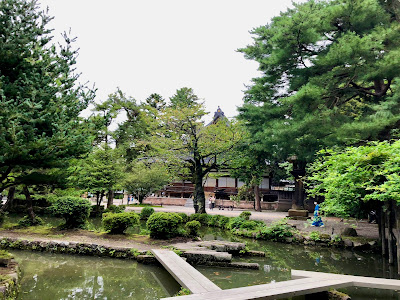 |
| 真ん中に鳳笙島 (笙島) 細長い石のジグザクが笙の形に似ているからのようです。 Hōshō -jima Island (Shō-jima Island) in the Centre It seems that the zigzag shape of the elongated stones resembles the shape of a Shō. |
 |
| 東側から / From the East Side |
 |
| 左の橋が琴橋のようです...? The bridge on the left seems to Koto-hashi Bridge...? |
D. 仄暗い / Gloomy
庭の北東、左手奥に近づくと、仄暗い雰囲気が漂います。
この日の天気のせいなのか、晴れていてもその雰囲気は漂っているのかはわかりません。
ここが神社の敷地と思えばこそ、歩いてみようという気持ちになりますが、でなければ、近づきたくない感じがしました。
通常なら、響音瀑からの水で、周辺は清められ、そんな雰囲気はしないのかもしれませんが、この日は水が流れるほどの量を保っていませんでした。
あるべきところに、滝は作られているのだと、ここに滝を作った昔の人の知恵に感心します。
Gloomy
As I approached the northeast corner of the garden, or on the far left, a dusk-like atmosphere fills the air.
I don't know if it's because of the weather that day, or if it's sunny, but that atmosphere is drifting.
If I think that here is the site of the shrine, I can feel like walking on, but if it were not, I wouldn't want to go near.
Normally, the water from the Kyō-on-baku Waterfall would purify the surrounding area, and it might not have that kind of atmosphere, but on this day, it didn't have enough water to flow.
I admire the wisdom of the ancient people who built the waterfall here, saying that the waterfall is built where it should be.
 |
池の主? / Lord of the Pond?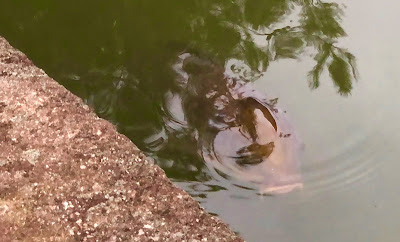 |
 |
| 水が少ない.... Water is scarce....  |
 |
| 響音瀑側から From Kyō-on-baku Waterfall Side |
5) "母子順風の像"
"Statue of Mother and Child in Fair Wind"
 |
 "母子順風の像", 1981 作:平野 富山 (ヒラノ フザン / 1911 - 1989) "Statue of Mother and Child in Fair Wind", 1981 By Fuzan Hirano (1911 - 1989)  |
「これは、いったい何をあらわしているのだろ〜?」
不思議さ満点の像を見つけました。
理解しようとあちらこちらから眺め、撮影しました。
結局理解はできませんでしたが、推測するに、母子ともに健やかに生活しているときは、順風の助けをかりながら、母親の尽力によって子供が守られている....。
'母の力と神による追い風で子供は育つ'、
'子供達よ、それを忘れずべからず'...という教訓も入っているのかもしれません。
ブロンズ像を中心に制作しましたが、彩色木彫作家 (サイショク モクチョウサッカ)でもありました: ★。
平野は、17才の時、人形師、池野哲仙(イケノテッセン)に弟子入りしました。
また生涯、彼が師と仰いだのは、平櫛 田中 (ヒラクシ デンチュウ / 1872 -1979)でした。
静岡市美術館 : ★には彼の彩色木彫作品が多数所蔵されているようです。
Statue of Mother and Child in Fair Wind
"What exactly does this represent~?"
I found a statue which is full of wonder.
I tried to understand this and looked at and photographed from here and there.
I couldn't understand it after all, but my guess is that when both the mother and child are living in good health, the child is protected by the mother's efforts with the help of the fair wind?
'Children grow with the power of the mother and the tailwind of God',
'Children, don't forget that'... maybe there's a lesson in that too.
A sculptor, Fuzan Hirano (1911 - 1989) made this sculpture.
He was born in Shimizu City, Shizuoka Prefecture, and his real name was Tomizo.
He mainly produced bronze statues, but he was also a coloured wood carving artist.
At the age of 17, Hirano became an apprentice to a doll maker, Tessen Ikeno (?-?).
The above biography has been summarized from the website of Shizuoka City Museum of Art.
Shizuoka City Museum of Art : ★ seems to have many of his colored wood sculptures.
6) さし石 / Strength Stones








